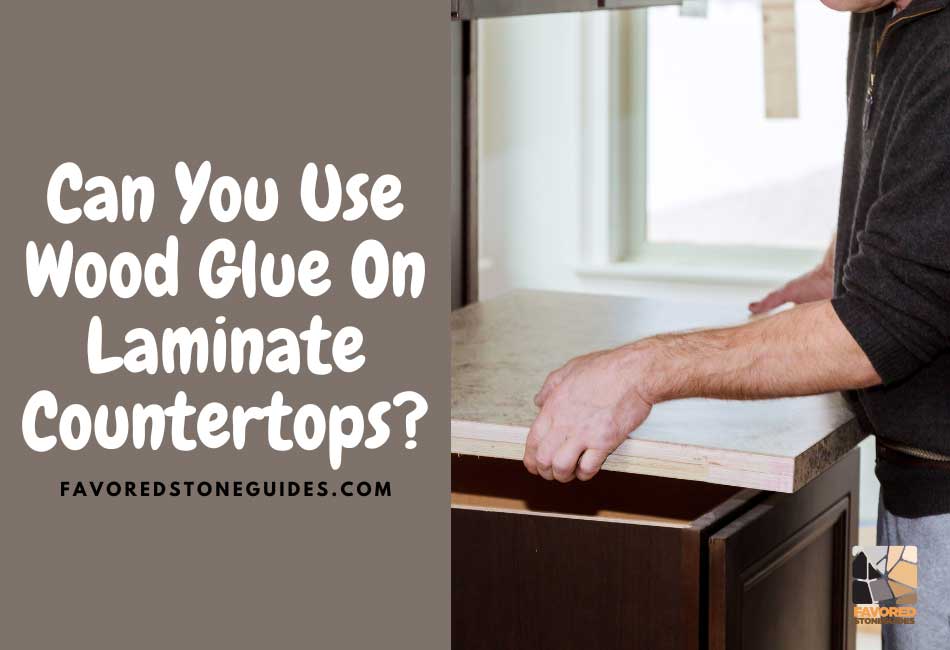As far as adhesives or glues go, a few different types can be used on laminate countertops. Some of the glue or adhesives you can use on your laminate countertops include contact cement, acrylic adhesive, and epoxy, to mention a few. But can you use wood glue on laminate countertops?
You can definitely use wood glue on laminate countertops when gluing the slab joint at a miter or seam joint. Likewise, you should be able to use wood glue together with some connector bolts. But when it comes to gluing laminate countertop sheets, wood glue is not the best option.
As you can see, there are certain instances where using wood glue on laminate countertops is perfectly fine, while in others, it’s not the best option. So, let’s continue exploring more on this topic more and some of the better alternatives for gluing laminate countertops.
But first, let’s try understanding what’s in wood glue and how it works so we can know why it’s not ideal for gluing laminate countertops.
Wood Glue
As the name implies, wood glue is used for woodworking projects. It is an adhesive that is water-based and specifically designed to bond two pieces of wood together.
It is also known as carpenters glue, school glue, or PVA glue (polyvinyl acetate). PVA glue is made up of long polymer chains suspended in water.
When the glue is applied to the surface of two wood pieces, the water evaporates, leaving behind the polymer chains.
These chains then start to interlock with the fibers in the wood, creating a strong bond between the two pieces.
Now that we know what’s in wood glue and how it works, let’s explore some of the reasons why it’s not ideal for gluing laminate countertops.
Reasons You Can’t Use Wood Glue For Mounting Laminate Countertop Sheets.
There are so many reasons why wood glue should not be used for gluing laminate countertop sheets.
1. Wood Glue Doesn’t Adhere Well to Non-Porous Surfaces
The first reason is that laminate countertops are non-porous. Non-porous surfaces do not allow the wood glue to penetrate and create a bond with the surface.
This means that the wood glue will not be able to create a strong bond between the laminate countertop and the adhesive, which could lead to the laminate countertop coming loose.
Additionally, non-porous surfaces do not allow the wood glue to dry properly, resulting in the adhesive not setting correctly and becoming tacky.
Tacky adhesives can attract dirt and dust, making the laminate countertop stained or discolored.
So as you can see, using wood glue on a non-porous surface like a laminate countertop is not ideal and can cause more harm than good.
2. Wood Glue Requires a Clamping Time of at Least 30 Minutes
Another reason you can’t use wood glue for mounting laminate countertop sheets is that it requires a minimum clamping time of 30 minutes.
If there is one thing you need to know about installing laminate countertops, it always needs to be done quickly and efficiently.
This is because laminate countertops are made up of multiple layers that need to be bonded together before they start to set.
Clamping down the laminate could result in the laminate sheet being uneven or not level.
It could also cause the laminate sheet to crack or break.
Additionally, trying to clamp down a large laminate sheet by yourself is nearly impossible.
You would need at least two people to help you clamp down the laminate sheet evenly, and even then, it would be a very difficult and time-consuming task.
Generally, when mounting your laminate sheet, you need to use an adhesive like the ones I will mention later in this post that doesn’t require clamping.
This will make the process easier, quicker, effective, and durable and reduce the risk of damaging your laminate sheet.
3. Wood Glue is Not as Durable as Other Adhesives
Another reason you shouldn’t use wood glue for mounting your laminate countertop sheet is that it’s not as durable as other adhesives.
Laminate countertops are constantly exposed to water, heat, and other elements that can cause the wood glue to break down over time.
This means that the bond between the laminate countertop and the adhesive will not last as long, and eventually, the laminate countertop will come loose.
So, if you’re looking for a durable and long-lasting adhesive for your laminate countertop, wood glue is not the way to go.
4. Wood Glue is Not as Flexible as Other Adhesives
Laminate countertops also need adhesives that can withstand movements, expansions, and vibrations.
This is because laminate countertops are constantly exposed to heat and humidity, which can cause them to expand or contract.
Many modern homes will have a washing machine or a dishwasher installed underneath their laminate countertops.
The vibrations from these appliances can also cause the laminate countertop to move, and if your adhesive is not flexible enough to absorb the shocks, it will crack.
If the adhesive cannot handle this expansion and contraction, it will eventually break down, and the laminate countertop will come loose.
5. Wood Glue is Not as Heat-Resistant As Other Adhesives
Wood glue is also not as heat-resistant as other adhesives. As a result, laminate countertops are constantly exposed to heat from hot pots, pans, and plates.
If the wood glue is not heat-resistant, it can start to break down and loosen over time. Therefore, using an adhesive specifically designed for laminate countertops is better.
These adhesives are made to withstand constant exposure to heat without breaking down. They will also form a stronger bond than wood glue.
6. Water Resistance
You must also use an adhesive resistant to water for your laminate countertops.
This is because laminate countertops are constantly exposed to water from spills, splashes, and condensation.
If the adhesive is not resistant to water, it can start to break down and loosen over time. Therefore, using an adhesive specifically designed for laminate countertops is better.
These adhesives are made to withstand constant exposure to water without breaking down. They will also form a stronger bond than wood glue.
Alternative Adhesives to Use for Laminate Countertops
Now that we’ve gone over why you shouldn’t use wood glue for your laminate countertop, let’s talk about some alternative adhesives you can use.
There are many different types of adhesives on the market specifically designed for laminate countertops, and each has its advantages and disadvantages.
The adhesive you choose will depend on your specific needs and preferences. Below, I will review some of the best types of adhesives for laminate countertops.
- Contact Cement
- Construction Adhesive
- Epoxy Adhesive
- Polyurethane Adhesive
- Silicon Adhesive
Let’s go over each of these adhesives in more detail.
Contact Cement
Contact cement is one of the best adhesives for laminate countertops. It is a robust and durable adhesive that can withstand heat and moisture. However, contact cement dries quickly, so you need to work fast when using it.
As far as bonding laminate goes, all you do is apply the contact cement to both surfaces you are joining together. Let it sit for about 20 minutes. Once the contact cement is dry, press the two surfaces together firmly.
Construction Adhesive
Construction adhesive is another type of adhesive that is specifically designed for laminate countertops.
This adhesive is applied to the underside of the laminate and then pressed into place. It is important to follow the manufacturer’s instructions when using this adhesive.
When bonding laminate using construction adhesive, it is important to remember a few things. First, this type of adhesive is permanent.
If you make a mistake, it will be tough to fix. Second, construction adhesive can be messy. Be sure to wear gloves and old clothes when using them.
Finally, construction adhesive needs time to cure. Therefore, you will need to wait several hours before using the countertop.
Epoxy Adhesive
Epoxy adhesive is another excellent option for bonding laminate countertops. This type of adhesive is very strong and durable.
It can also withstand exposure to heat and moisture. The only downside to epoxy adhesive is that it takes longer to cure than other types of adhesives. You will need to wait 24 hours before using the countertop.
Polyurethane Adhesive
Polyurethane adhesive is another great option for bonding laminate countertops. This type of adhesive is very strong and provides a waterproof seal, making it ideal for areas exposed to moisture.
Polyurethane adhesive can be applied with a caulking gun and set in about 24 hours. Once the adhesive has set, you can then apply grout or caulk to the seams between the countertop and the backsplash. Be sure to use a color-matched caulk or grout to blend in with the laminate.
Silicone Adhesive
Silicone is another type of adhesive that can also be used for laminate countertops. This type of adhesive forms a waterproof seal and can withstand exposure to moisture.
It can also be used in high-heat areas, making it ideal for bonding laminate countertops near stoves or sinks. Silicone adhesive takes 24 hours to set and can be applied with a caulking gun.
Now that you know some of the best adhesives for laminate countertops, you can choose the one that is right for your needs. Follow the manufacturer’s instructions when using any of these adhesives.
Final Thoughts
When it comes to whether you can use wood glue on laminate countertops, the answer is not a definitive no because there are some instances where it may be the best option. However, in most cases, it is best to use a different type of adhesive for your laminate countertops.
A good example is contact cement, a strong, durable adhesive that can withstand heat and moisture. Another option is construction adhesive which is applied to the underside of the laminate and then pressed into place.
Epoxy adhesive is another great option for bonding laminate countertops. This type of adhesive is very strong and durable.
I hope this article helped answer the question about whether or not you use wood glue on laminate countertops. Thanks for sticking around!

